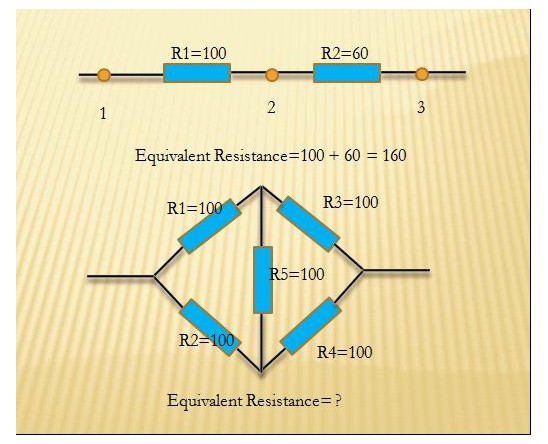HDU 3976 (高斯消元 KCL方程)
2015-12-09 19:55
381 查看
Electric resistance
Time Limit: 2000/1000 MS (Java/Others) Memory Limit: 32768/32768 K (Java/Others)Total Submission(s): 498 Accepted Submission(s): 259
Problem Description
Now give you a circuit who has n nodes (marked from 1 to n) , please tell abcdxyzk the equivalent resistance of the circuit between node 1 and node n. You may assume that the circuit is connected. The equivalent resistance of the circuit between 1 and n is
that, if you only consider node 1 as positive pole and node n as cathode , all the circuit could be regard as one resistance . (It's important to analyse complicated circuit ) At most one resistance will between any two nodes.

Input
In the first line has one integer T indicates the number of test cases. (T <= 100)
Each test first line contain two number n m(1<n<=50,0<m<=2000), n is the number of nodes, m is the number of resistances.Then follow m lines ,each line contains three integers a b c, which means there is one resistance between node a and node b whose resistance
is c. (1 <= a,b<= n, 1<=c<=10^4) You may assume that any two nodes are connected!
Output
for each test output one line, print "Case #idx: " first where idx is the case number start from 1, the the equivalent resistance of the circuit between 1 and n. Please output the answer for 2 digital after the decimal point .
Sample Input
1 4 5 1 2 1 2 4 4 1 3 8 3 4 19 2 3 12
Sample Output
Case #1: 4.21
真是个神题啊,给跪了~~深深地感受到了来自电路原理的恶意。
题意是给出电路上的n个点,然后m个电阻,告诉你每个电阻所在的左右两个点,求所有电阻的等效电阻。
根据基尔霍夫定律,流入或流出某一节点的所有之路的电流代数和为0。我们假设这些点是0-n-1并且0这个点的电势为0,那么只需要求出n-1这个点的电势。假设流入1的总电流是1A,那么等效电阻在数值上等于n-1这个点的电势。
然后根据基尔霍夫定律对每一个电阻更新KCL方程,x[i]表示i这个点的电势。
最后注意第一个点的电势是已知的,假设是0。因为我们无法求出每个点的绝对电势。如果忘记这一点KCL方程会跑出很奇怪的答案,因为解没有唯一性。
#include <bits/stdc++.h>
using namespace std;
#define maxn 111
#define eps 1e-9
double a[maxn][maxn], x[maxn];
int n, m;
int equ, var;
int Gauss () {
int i, j, k, col, max_r;
for (k = 0, col = 0; k < equ && col < var; k++, col++) {
max_r = k;
for (int i = k+1; i < equ; i++) { //找到最大的数所在的行
if (fabs (a[i][col]) > fabs (a[max_r][col]))
max_r = i;
}
if (k != max_r) { //交换行
for (int j = col; j <= var; j++) {
swap (a[k][j], a[max_r][j]);
}
}
for (int i = k+1; i < equ; i++) { //消去
if (a[i][col]) {
double tmp = -a[i][col]/a[k][col];
for (int j = col; j <= var; j++) {
a[i][j] += tmp*a[k][j];
}
}
}
}
for (int i = equ-1; i >= 0; i--) { //回代
double tmp = a[i][var];
for (int j = i+1; j < var; j++) {
tmp -= x[j]*a[i][j];
}
x[i] = tmp/a[i][i];
}
return 1;
}
int main () {
//freopen ("in", "r", stdin);
int kase = 0, t;
cin >> t;
while (t--) {
cin >> n >> m;
memset (a, 0, sizeof a);
equ = n, var = n;
a[0][var] = 1, a[n-1][var] = -1;
for (int i = 1; i <= m; i++) {
int u, v;
double r;
cin >> u >> v >>r; if (v < u) swap (u, v);
u--, v--;
a[u][u] -= 1.0/r;
a[u][v] += 1.0/r;
a[v][v] -= 1.0/r;
a[v][u] += 1.0/r;
}
for (int i = 0; i < n; i++) {
a[i][0] = 0;
}
Gauss ();
printf ("Case #%d: %.2f\n", ++kase, x[n-1]);
}
return 0;
}
相关文章推荐
- 消毒
- Maximum file handles allowed by OS
- 利用PL/SQL导出Oracle数据表结构
- Nuget,程序员的功能包
- hibernate cascade属性 all-delete-orphan
- leetcode Excel Sheet Column Number
- Nuget,程序员的功能包
- 在Web应用中接入微信支付的流程之极简清晰版
- Django 基础教程
- ssh, maven and eclipse 那些破事
- visual studio开启多核编译方法
- JavaScript中的类与对象
- android屏幕适配终极指南(一):DPI,分辨率和屏幕尺寸
- 一篇介绍NStimer深层原理的文章
- Error:ERROR ITMS-90474: "Invalid Bundle. iPad Multitasking support requires these orientations:
- leetcode Rotate Array
- Permission denied: user=xxj, access=WRITE, inode="user":hadoop:supergroup:rwxr-xr-x
- 1059: [ZJOI2007]矩阵游戏
- 利用结点数据类型,求两个一元多项式的和
- http协议head详解
